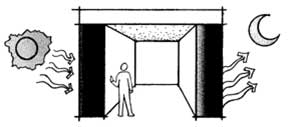Energy Efficiency
(Excerpted from Take Credit for a Good Design, published by CMACN)
We design buildings with masonry for many reasons . . . to be attractive and comfortable, to be durable, to keep out wind, rain and noise. We can also use masonry for energy efficiency.
Thermal Mass Saves Energy
Thermal mass in masonry walls moderates the day/night temperature swings and reduces heat flow to the interior, which reduces air conditioning loads inside the building.
For thousands of years, designers and builders have understood the valuable qualities of masonry, but many have become confused about its role in building energy performance. Because of an emphasis on high insulation levels, the importance of thermal mass has been overlooked.
We've become more sophisticated about energy efficiency, however, and have now quantified and accepted the benefits of thermal mass. The newest energy standards recognize this quality of masonry walls, allowing a reduction in insulation requirements as wall heat capacity increases.
Masonry Walls Offer Thermal Mass
The biggest energy problem in commercial buildings has been to remove unwanted heat. Internal heat gains from lights, equipment and people lead to year-round air conditioning. Outdoor heat gains just add to the problem. But the thermal mass of masonry allows it to absorb much of the heat, reducing the load on the air conditioning system.


 Composite Masonry
Composite Masonry

